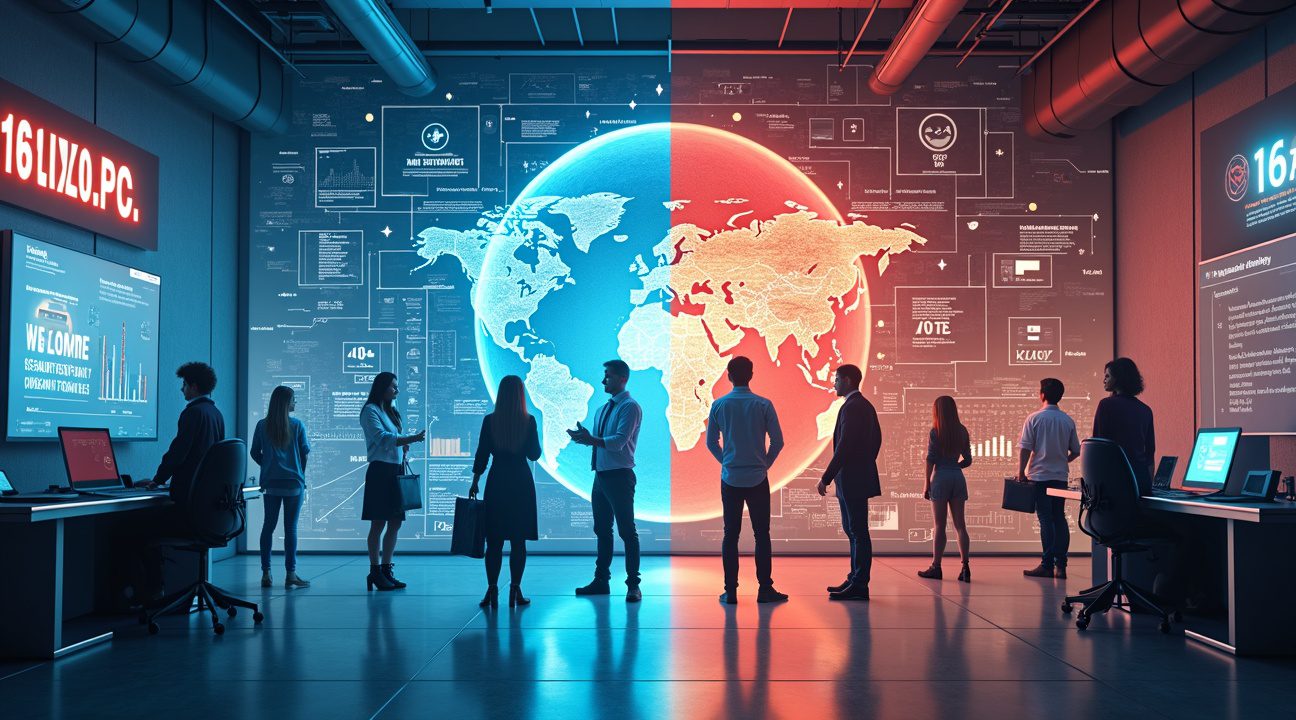China launched its new K-Visa program on October 1, 2025, specifically targeting young STEM talent just ten days after the United States implemented a staggering $100,000 fee for new H-1B visa applications.
Key Takeaways
- China’s K-Visa offers a streamlined pathway for young STEM professionals with minimal financial barriers, requiring only a bachelor’s degree and emphasizing qualifications over economic gatekeeping.
- The U.S. H-1B program now demands $100,000 in filing fees plus additional charges up to $4,500, creating substantial financial hurdles that particularly impact startups and small-to-medium enterprises.
- Contrasting policy timing creates a stark choice for international talent between expensive but established American opportunities and affordable Chinese alternatives.
- Companies restructure hiring strategies by establishing international offices, partnering with offshore teams, and investing more heavily in domestic workforce development to manage new visa costs.
- Young professionals now face a shift in career planning where visa accessibility and associated costs become primary factors in destination selection, potentially redirecting global talent flows away from traditional U.S. tech hubs.
The timing of China’s K-Visa launch represents a masterstroke of diplomatic chess. While America builds financial walls around its most coveted work visas, China opens its doors wider than ever before. International STEM graduates find themselves at a crossroads where fiscal reality shapes career trajectories more than professional aspirations.
China’s approach contrasts sharply with recent American policy changes. The K-Visa eliminates most traditional bureaucratic hurdles and reduces application costs to under $500. Compare this with the new American system where filing fees alone exceed the annual salary of many entry-level positions in developing countries.
Impact on U.S. Technology Sector
American technology companies already struggle with the financial burden these changes impose. Small startups that once relied on international talent to fill critical positions now face impossible mathematics. Larger corporations absorb these costs but pass them through reduced hiring or stricter qualification requirements.
The ripple effects extend beyond individual companies or workers. Silicon Valley’s talent pipeline faces disruption as international students reconsider their post-graduation plans. Universities report declining enrollment in graduate programs from international students who previously viewed American education as a pathway to American employment.
China’s Strategic Recruitment
China positions itself as the beneficiary of this policy shift. Beijing’s new program targets the exact demographic that historically fueled American innovation: young, educated, technically skilled professionals willing to relocate for career opportunities. The K-Visa specifically courts individuals under 35 with STEM backgrounds, offering three-year renewable permits with clear paths to permanent residency.
U.S. Justifications and Criticism
American policy makers argue the fee increases generate necessary revenue while ensuring only serious employers participate in the H-1B system. Critics counter that such barriers primarily harm legitimate small businesses while larger corporations find workarounds through offshore development centers or consultancy arrangements.
Challenges for International Graduates
International students completing degrees in American universities face particularly difficult decisions. Many invested years and significant resources in American education expecting to launch careers in American companies. The new fee structure makes this pathway financially unrealistic for many graduates from middle-income backgrounds.
Beyond Visas: China’s Long-term Vision
Chinese recruitment efforts extend beyond simple visa policy. The country simultaneously invests billions in research infrastructure, offers competitive salaries in major cities, and creates English-speaking work environments specifically designed to attract international talent. These comprehensive efforts demonstrate strategic planning that extends beyond immigration policy alone.
Corporate Response
American companies adapt through various strategies. Some establish satellite offices in countries with more favorable visa policies. Others increase reliance on remote work arrangements or contract relationships with international talent. Large corporations explore partnerships with foreign consultancies to access international expertise without direct employment relationships.
Broader Global Competitiveness
The broader implications affect global competitiveness in emerging technologies. As artificial intelligence, renewable energy, and biotechnology reshape economic landscapes, access to top international talent becomes increasingly crucial. Countries that create barriers to such talent may find themselves at strategic disadvantages in future technological races.
Unintended Consequences and Trends
Market observers note that visa policy changes often produce unintended consequences. While intended to protect domestic workers or generate revenue, restrictive policies frequently redirect talent flows rather than reduce overall migration. China’s K-Visa program demonstrates how quickly competing nations can capitalize on such policy gaps.
Professional networks already show adaptation patterns. LinkedIn data indicates increased interest in Chinese job opportunities among STEM professionals who previously focused exclusively on American positions. Career counselors report more inquiries about Chinese language learning and cultural preparation programs.
Practical Impacts on Hiring and Planning
The financial disparity between these systems creates practical planning challenges for both individuals and employers. Companies budgeting for international hires must now allocate significantly more resources per position, potentially reducing total hiring numbers. Individuals must weigh career opportunities against visa costs that can exceed their first year’s disposable income.
Educational Institution Response
Educational institutions face pressure to adjust their international student services. Career centers develop new resources focused on alternative destination countries while maintaining traditional American placement support. Some universities explore partnerships with Chinese institutions to create dual-degree programs that facilitate easier transitions to Chinese employment.
Evolving Legal Landscape
Immigration attorneys observe fundamental shifts in client consultation patterns. Where discussions previously centered on application timing and qualification requirements, conversations now begin with cost-benefit analyses of different destination countries. The legal profession itself adapts by developing expertise in multiple national visa systems rather than specializing exclusively in American immigration law.
Knowledge Transfer and Brain Drain
Technology transfer implications emerge as international talent considers Chinese opportunities. Professionals trained in American institutions and companies may carry valuable knowledge and networks to new positions in China. This brain drain concern motivates some American policy discussions about creating more balanced approaches to high-skilled immigration.
Regional Economic Impact
Regional economic impacts vary significantly across American metropolitan areas. Cities heavily dependent on international talent for technology sectors face more severe disruptions than regions with primarily domestic workforces. Seattle, San Francisco, and Boston report particular concern about their ability to maintain innovation ecosystems under the new fee structure.
Execution Will Determine Success
China’s program success will depend largely on execution rather than just policy design. Creating genuinely attractive work environments for international professionals requires sustained investment in infrastructure, cultural integration support, and professional development opportunities. Early reports suggest Chinese employers are making substantial efforts in these areas.
Expanded Options for Global Talent
The competition between these approaches may ultimately benefit international professionals by creating more diverse career options. Rather than viewing this as a zero-sum contest between America and China, the situation potentially expands global opportunities for qualified individuals willing to consider multiple destinations.
Looking Ahead
Long-term implications for American competitiveness remain unclear. History suggests that talent restrictions often produce short-term benefits while creating longer-term strategic disadvantages. However, American technology leadership has historically proven resilient, and domestic innovation capacity continues developing regardless of international hiring constraints.
Global migration patterns typically adjust to policy changes over time. If Chinese programs prove successful in attracting high-quality international talent, other countries may implement similar approaches. This could create a competitive dynamic that ultimately benefits skilled professionals through expanded options and improved conditions across multiple destinations.
The K-Visa represents more than simple immigration policy; it signals China’s broader strategy for competing in knowledge-based industries. Success in attracting international STEM talent supports domestic innovation goals while potentially weakening competitors’ technological capabilities. This strategic dimension elevates immigration policy from administrative procedure to economic competition tool.
U.S. Slaps $100,000 Fee on H-1B Visas While China Opens Doors with New K-Visa
The immigration landscape for skilled workers shifted dramatically on September 21, 2025, when the United States implemented a staggering $100,000 one-time fee for new H-1B visa filings. This massive increase represents one of the most significant policy changes in the program’s history, affecting how U.S. companies recruit international talent across technology, engineering, and healthcare sectors.
I’ve observed how this fee structure fundamentally alters the economics of hiring foreign workers. Previously, employers faced filing costs ranging from $1,700 to $4,500 depending on company size and optional services. Now they must budget an additional $100,000 for each new petition, though existing approvals, pending applications, renewals, and transfers remain exempt from this charge.
Impact on America’s Tech Workforce
With approximately 750,000 H-1B holders currently working in the United States as of 2025, this policy shift affects a substantial portion of the skilled workforce. The Department of Labor’s directive to raise prevailing wage levels for H-1B workers compounds these costs, creating additional financial pressure on employers seeking international talent.
Companies must now weigh whether the $100,000 investment justifies hiring specific candidates, potentially limiting opportunities for skilled workers from abroad. This cost barrier could drive businesses to:
- Explore alternative hiring strategies
- Relocate operations to countries with more favorable immigration policies
- Invest more heavily in domestic workforce development
China’s Strategic Response
China responded swiftly to America’s restrictive move by launching its K visa program on October 1, 2025, just ten days after the U.S. fee implementation. This timing appears deliberate, positioning China as an attractive alternative destination for young foreign professionals in science and technology fields.
The K visa represents China’s direct attempt to capitalize on America’s new barriers to entry. By creating pathways for the same talent pool that now faces significant financial obstacles in the U.S., China positions itself to attract high-potential professionals who might otherwise have chosen American opportunities.
This competitive dynamic reflects broader geopolitical tensions over talent acquisition. While China developer companies continue expanding globally, the country’s new visa program signals an aggressive push to build domestic expertise by attracting international minds.
The contrast couldn’t be starker: America raises barriers while China lowers them. For skilled workers evaluating their options, the choice between paying substantial fees to work in the U.S. versus exploring new opportunities in China through the K visa program represents a fundamental shift in global talent mobility patterns.

China’s K-Visa: A Strategic Play for Young STEM Talent
China has introduced a groundbreaking K visa specifically designed to attract foreign graduates and young professionals in STEM fields from recognized universities and research institutions worldwide. This new visa category represents China’s most direct response to global talent competition, particularly as other nations implement restrictive immigration policies that price out young professionals.
The K visa becomes China’s 13th official visa category, joining the established framework that includes Z visas for work, X visas for study, M visas for business, and Q visas for family reunion purposes. This strategic positioning is particularly significant because it creates a dedicated pathway exclusively for STEM talent, rather than forcing these professionals through existing work visa channels that often carry additional restrictions and bureaucratic hurdles.
Eligibility Requirements and Target Demographics
Foreign graduates with at least a bachelor’s degree in science, technology, engineering, or mathematics fields qualify for the K visa, as do young professionals currently involved in relevant educational or research roles. The program deliberately casts a wide net to capture emerging talent at various career stages, from recent university graduates to early-career researchers making their mark in their respective fields.
This approach differs significantly from traditional work visa programs that typically require established employment relationships or extensive professional experience. China’s strategy focuses on potential rather than proven track records, positioning the country to benefit from innovative technologies and research breakthroughs that these young professionals might develop throughout their careers.
Legal Framework and Implementation Timeline
The K visa operates under Order No. 814, which establishes the legal foundation for this new immigration pathway. Entry-exit regulation enforcement begins October 1, 2025, giving both Chinese authorities and potential applicants time to prepare for implementation. This timeline suggests China has planned this initiative carefully, likely anticipating increased demand as other countries tighten their immigration policies.
The visa specifically emphasizes welcoming science and technology professionals through flexible pathways that minimize administrative and financial hurdles. Where traditional visa applications often require extensive documentation, multiple interviews, and substantial fees, the K visa streamlines these processes to reduce barriers that might discourage talented individuals from pursuing opportunities in China.
China’s broader global talent strategy becomes evident through this initiative. The country recognizes that innovation capacity depends heavily on attracting international expertise, particularly in rapidly evolving technological fields where fresh perspectives and diverse educational backgrounds drive breakthrough discoveries. By reducing entry barriers, China positions itself as an attractive alternative for professionals who might otherwise face prohibitive costs or lengthy approval processes elsewhere.
The timing of this announcement reflects sophisticated strategic thinking. As other nations implement policies that effectively price out young talent through excessive fees or administrative complexity, China creates a more accessible pathway that appeals directly to the demographic most likely to drive future innovation. This demographic represents exactly the kind of human capital that nations compete for in the global knowledge economy.
The K visa’s emphasis on flexibility extends beyond simple application processes. Unlike rigid work visa categories that tie individuals to specific employers or locations, this new framework appears designed to give recipients greater freedom in pursuing research collaborations, entrepreneurial ventures, or academic positions. Such flexibility proves particularly valuable for STEM professionals whose work often transcends traditional organizational boundaries.
China’s initiative demonstrates how immigration policy can serve as a competitive tool in the global talent marketplace. By creating dedicated pathways for STEM professionals while maintaining streamlined application processes, the country signals its commitment to building innovation capacity through international recruitment. The strategic timing of this announcement, coinciding with increased immigration costs elsewhere, positions China to capture talent that might otherwise contribute to competitors’ innovation ecosystems.
This comprehensive approach to talent acquisition reflects China’s understanding that technological advancement and economic growth increasingly depend on attracting the world’s brightest minds, regardless of their nationality or current location.
How the $100,000 H-1B Fee Changes Everything for U.S. Tech Hiring
The Trump administration’s executive action introducing a staggering $100,000 H-1B petition fee represents a seismic shift in America’s approach to skilled foreign worker recruitment. This dramatic increase stems from policy goals aimed at reducing perceived exploitation of the visa program while better protecting domestic workers and limiting lower-wage foreign hires. The Department of Labor wage mandates now accompanying these changes further restrict specialty occupation classifications, fundamentally altering how companies approach international talent acquisition.
Financial Barriers Transform the Hiring Landscape
Tech companies across America now confront application costs that can exceed $100,000 per worker, creating an immediate financial deterrent for employers considering international talent. This cost explosion particularly impacts startups and small-to-medium-sized enterprises, which typically operate with constrained budgets and cannot absorb such substantial hiring expenses. Many emerging companies that previously relied on H-1B workers to fill critical technical roles now find themselves priced out of accessing global talent pools.
The ripple effects extend beyond initial hiring costs. Companies must now factor these expenses into their long-term workforce planning, potentially reducing the overall number of international hires they can afford. Strategic planning for tech firms has become increasingly complex as they balance talent needs against these new financial realities.
The Great Talent Redistribution
Industry experts increasingly warn of a potential “reverse brain drain” as the estimated 750,000 current visa holders and prospective applicants reconsider their career trajectories. Young skilled workers who once viewed America as the ultimate destination for tech careers now explore alternative markets offering more accessible pathways. This shift particularly benefits countries positioning themselves as talent magnets through streamlined immigration processes.
Multinational corporations face pressure to reevaluate their international hiring strategies and research collaborations. Companies that previously centralized operations in the United States now consider distributing talent across global offices where visa restrictions prove less prohibitive. Innovation hubs in other countries stand to benefit from this redistribution of human capital.
The policy changes create cascading effects throughout the tech ecosystem:
- Research institutions lose access to international graduate students and postdoctoral researchers who might have transitioned to industry roles.
- Technology development timelines may extend as companies struggle to fill specialized positions with domestic candidates alone.
- Venture capital firms now weigh immigration policies when evaluating startup investments, recognizing that talent acquisition challenges directly impact company growth potential.
The traditional Silicon Valley model of attracting global talent faces its most significant challenge in decades, forcing a fundamental reassessment of how American tech companies build their teams.
The $100,000 fee essentially transforms the H-1B program from a broad talent acquisition tool into a luxury reserved for only the most well-funded organizations. This shift represents more than a simple cost increase—it signals a complete philosophical change in how America approaches skilled immigration. Companies that built their competitive advantages on accessing diverse international talent pools must now navigate an entirely different landscape where such access comes at premium prices.
Early indicators suggest that many companies are already adjusting their hiring practices, focusing more heavily on domestic talent development while exploring alternative visa categories for international workers. Performance metrics for HR departments now include immigration cost management alongside traditional recruitment efficiency measures.
The specialty occupation classification requirements have tightened considerably, making even successful applications more challenging to obtain. Companies must now demonstrate not only the need for international talent but also justify the substantial financial investment required to secure it. This dual burden of increased costs and heightened scrutiny fundamentally reshapes the American tech hiring landscape, creating opportunities for competing nations to attract the very talent that once flowed primarily to the United States.

Tale of Two Visa Policies: China vs. U.S. Approach to Global Talent
China’s newly announced K visa represents a stark departure from traditional immigration policies, specifically designed to capture young STEM professionals with minimal financial barriers. The program requires only a bachelor’s degree as the minimum qualification and maintains deliberately low application costs, emphasizing credentials and expertise over economic gatekeeping. This approach directly contrasts with recent U.S. policy changes that have fundamentally altered the landscape for international talent acquisition.
The timing of these competing policies reveals a strategic chess match between two global superpowers. China’s K visa launches October 1, 2025, arriving just days after the U.S. implemented its controversial H-1B fee structure on September 21, 2025. The American program now demands a staggering $100,000 filing fee, supplemented by additional charges ranging from $1,700 to $4,500, creating substantial financial hurdles for both employers and applicants.
Strategic Differences in Target Demographics and Goals
I observe distinct philosophical approaches driving these policy decisions. China’s K visa explicitly targets younger professionals across all STEM disciplines, betting on innovation potential and long-term economic contribution. The program prioritizes documentation and qualifications, making it accessible to recent graduates and early-career professionals who might lack extensive financial resources but possess cutting-edge skills.
Meanwhile, the H-1B program casts a wider net across age groups but creates significant economic barriers that effectively filter candidates based on employer willingness to invest substantial sums. The U.S. policy signals a clear intent to reduce foreign hiring volume while simultaneously driving up domestic wage levels through artificial scarcity.
These contrasting approaches reflect fundamentally different economic strategies:
- China: Positions itself as the destination for young, ambitious STEM talent seeking opportunities without prohibitive costs. The country appears willing to absorb administrative expenses in exchange for accessing fresh perspectives and emerging technologies that could fuel long-term innovation growth.
- United States: Suggests confidence in its existing talent pool and market appeal, using financial barriers as a mechanism to prioritize only the most economically valuable foreign workers. This strategy assumes employers will absorb massive costs only for truly irreplaceable talent, effectively reducing overall foreign recruitment while maintaining selective access to exceptional candidates.
The broader implications extend beyond individual career decisions. China’s low-barrier entry system could attract professionals who might have previously viewed the U.S. as their primary destination, potentially reshaping global talent flows. Young STEM professionals now face a choice between expensive but established American opportunities and affordable but emerging Chinese alternatives, creating a competitive dynamic that may influence technological advancement patterns worldwide.
The New Global Competition for Innovation Talent
China’s strategic launch of the K visa represents a calculated move to capitalize on shifting global talent dynamics, particularly as the United States implements substantial financial barriers for skilled workers. The timing isn’t coincidental—Beijing recognizes that America’s new $100,000 H-1B visa fee creates an unprecedented opportunity to attract top-tier STEM graduates who might otherwise choose Silicon Valley or other U.S. tech hubs.
This visa policy divergence signals a fundamental shift in how nations approach foreign workforce integration. While the U.S. creates financial obstacles that potentially exclude many qualified candidates, China opens its doors wider, offering streamlined pathways for young innovators. I observe that this contrast reflects deeper philosophical differences about the role of international talent in driving economic growth.
Strategic Implications for Global STEM Mobility
The K visa initiative demonstrates China’s understanding that modern innovation competitiveness extends far beyond traditional R&D investments. Countries must now actively compete for human capital, recognizing that breakthrough technologies often emerge from diverse, international teams. This competition has intensified as several factors converge:
- Growing global demand for AI, quantum computing, and biotechnology expertise
- Increased mobility among young professionals willing to relocate for career opportunities
- Rising costs of education making financial incentives more attractive to graduates
- Geopolitical tensions that influence career decisions among international students
Policymakers across both nations closely monitor these developments, understanding that talent acquisition strategies directly impact long-term technological leadership. Recruiters in the tech sector now factor visa accessibility into their global hiring strategies, while universities adjust their international student recruitment based on post-graduation opportunities.
The implications extend beyond individual career choices. Flying car technology and other emerging innovations depend heavily on international collaboration and talent exchange. Companies developing cutting-edge technologies must now consider how visa policies affect their ability to assemble world-class teams.
Academic institutions particularly feel these policy shifts, as they influence where promising researchers choose to build their careers. The H-1B fee hike may redirect talent flows that have historically favored American universities and research centers. Meanwhile, China’s K visa creates new pathways for graduates who previously saw limited options outside Western countries.
These competing visa policies represent more than administrative changes—they reflect fundamental strategic decisions about national competitiveness in the global innovation economy. International collaboration in various fields demonstrates how talent mobility drives innovation across sectors.

What This Means for Young Professionals and Tech Companies
I see a fundamental shift happening in how young professionals and tech companies approach international talent strategies. The stark contrast between these new visa policies creates distinct paths that will reshape career decisions and business operations across multiple industries.
Impact on Employers and Hiring Strategies
The $100,000 H-1B fee represents a significant financial barrier that many employers simply can’t absorb. Startups and small to medium enterprises will feel this burden most acutely, as they often operate with tight budgets and limited resources for international recruitment. I observe that these companies may need to fundamentally restructure their hiring approaches, potentially focusing more heavily on domestic talent or exploring alternative visa categories.
Larger corporations with substantial resources might absorb these costs, but even they’ll likely become more selective about which international candidates justify the investment. This selectivity could concentrate H-1B applications among the most highly skilled or specialized professionals, fundamentally changing the competitive landscape for these visas.
Companies are already exploring several strategic alternatives to manage these changes:
- Establishing international offices in countries with more favorable visa policies
- Partnering with offshore development teams instead of bringing talent to the U.S.
- Investing more heavily in domestic training and development programs
- Exploring other visa categories like O-1 visas for exceptional ability candidates
Career Decision Framework for Young Professionals
Young professionals now face a clear cost-benefit analysis when planning their international careers. The U.S. pathway offers access to Silicon Valley’s established ecosystem, higher salaries, and extensive professional networks, but at a premium price that their employers might not be willing to pay. China’s K-Visa presents a lower-cost alternative with growing opportunities in emerging technologies like AI, fintech, and green energy.
I notice that timing has become crucial in this decision-making process. The simultaneous introduction of these policies suggests deliberate competition between the two nations for the same talent pool. For STEM graduates, particularly those from countries with strong relationships with both the U.S. and China, visa accessibility and associated costs will likely become primary factors in destination planning.
The flexibility offered by China’s new visa program appeals especially to younger professionals who value adaptability and are willing to explore emerging markets. Meanwhile, those seeking stability and established career paths may still gravitate toward the U.S., despite the higher financial barriers.
International students currently studying in either country face particularly complex decisions. Those in U.S. institutions must weigh whether their employers will absorb the new fees, while students in other countries can now more easily compare the total cost and opportunity structure between these two major destinations.
Recent developments in other sectors, from aviation technology to entertainment industries, demonstrate how quickly global markets can shift. Similarly, the talent mobility landscape appears to be experiencing rapid transformation that will require continuous adaptation from both professionals and employers.
The competition for global talent reflects broader geopolitical dynamics, with each country leveraging immigration policy as a tool for economic advantage. Young professionals who can navigate these changing policies effectively will find themselves with significant leverage in the job market, while those who fail to adapt may find their options more limited than previous generations experienced.
These policy changes signal a new era where visa accessibility becomes as important as salary and career prospects in international job decisions. Companies that recognize this shift early and adjust their recruitment strategies accordingly will maintain competitive advantages in attracting top global talent.

Sources:
China Briefing – China’s Revised Entry-Exit Rules Introduce New K-Visa for Young Science and Technology Talent
CBS News – Trump Administration to Add $100,000 Fee for H-1B Visas
Employment Law Worldview – Understanding the New $100,000 H-1B Fee and Its Effect on US Employers
Times Higher Education – China Unveils New Visa to Lure Young Science and Tech Specialists
Boundless – Trump Administration Signs Proclamation Declaring New $100,000 Fee for H-1B Visa Applications
Government of China (gov.cn) – content_6984234


